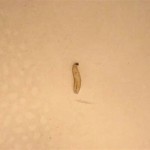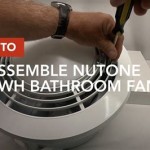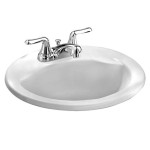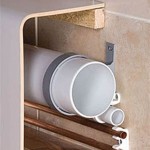Understanding Bathroom Sink Drain Configurations
The bathroom sink drain, often overlooked, is a critical component of the plumbing system. Its primary function is to effectively remove wastewater from the sink basin and direct it into the main drain line, preventing clogs and maintaining hygiene. The configuration of this drain system involves several interconnected parts working in concert. This article will delve into the essential components, configurations, and considerations involved in bathroom sink drain systems. Proper understanding of these systems allows for informed decisions regarding installation, repair, and maintenance.
A typical bathroom sink drain system consists of several key parts. The strainer, located directly in the sink basin's drain opening, prevents large objects from entering and obstructing the drainpipe. A tailpiece, a short pipe, connects directly beneath the strainer and extends downward. The P-trap, a curved pipe, is a crucial component designed to trap water, forming a seal that prevents sewer gases from entering the bathroom. Finally, the drainpipe connects the P-trap to the main drain line within the wall of the bathroom. Understanding the function of each part is important to troubleshooting common drain issues.
Essential Components of a Bathroom Sink Drain
The strainer serves as the first line of defense against clogging. It usually consists of a metal or plastic basket with perforations that allow water to pass through while capturing hair, soap scum, and other debris. Strainers come in various designs, some with a simple lift-and-turn mechanism to open and close, while others incorporate a pop-up mechanism controlled by a lever. The choice of strainer often depends on personal preference and the style of the sink and faucet.
The tailpiece connects directly to the strainer and extends downward. It is typically made of PVC, brass, or chrome-plated brass. The tailpiece’s length can vary, allowing for adjustments to align with the P-trap. A secure connection between the strainer and tailpiece is vital to prevent leaks. Plumber's putty or a rubber gasket is often used to create a watertight seal.
The P-trap is arguably the most important component of the drain system. Its curved design creates a water seal that prevents noxious sewer gases from entering the bathroom. These gases, composed of methane, hydrogen sulfide, and other potentially harmful substances, can pose a health risk if allowed to escape into the living space. The P-trap's water seal acts as a barrier, blocking the passage of these gases. Regular use of the sink replenishes the water in the P-trap, ensuring its continued effectiveness. In sinks that are infrequently used, the water in the P-trap can evaporate, allowing sewer gases to enter the room. In such cases, simply running water down the drain will restore the seal.
The drainpipe connects the P-trap to the main drain line within the bathroom wall. It can be made of PVC, ABS, or metal, depending on local plumbing codes and personal preference. The drainpipe's diameter is typically 1 1/2 inches, although larger sizes may be required in some installations. Proper alignment and secure connections between the P-trap and drainpipe are essential to prevent leaks and ensure efficient drainage. The drainpipe must be properly vented to allow air to enter the drain system, preventing a vacuum that could impede water flow.
Common Bathroom Sink Drain Configurations
There are several common configurations for bathroom sink drain systems, each with its advantages and disadvantages. The most prevalent configuration involves a standard P-trap directly connected to the sink tailpiece. This setup is relatively simple to install and maintain, making it a popular choice for residential applications. However, in situations where space is limited, alternative configurations may be necessary.
Bottle traps, also known as European traps, are a more compact alternative to the traditional P-trap. They feature a cylindrical body that collects water to form the necessary seal. Bottle traps are often used in modern bathroom designs where aesthetics are a primary concern. Unfortunately, they can be more prone to clogging than P-traps, as the smaller diameter of the trap can restrict flow. Regular cleaning and maintenance are essential to keep bottle traps functioning properly.
S-traps, an older design, are now generally prohibited by plumbing codes in many jurisdictions. The S-trap features a downward curve followed by an upward curve before connecting to the drain line. This design is prone to siphonage, where the entire water seal is sucked out of the trap, allowing sewer gases to enter the room. Replacing S-traps with P-traps is a common plumbing upgrade to ensure compliance with current codes and prevent sewer gas intrusion.
Another drain configuration involves a pop-up drain, commonly found in modern sinks. These drain systems use a lever or button to raise and lower a stopper in the sink opening, allowing water to be retained or released. While convenient, pop-up drains can be more complex to install and maintain than traditional strainers. The linkage between the lever and stopper can become misaligned or corroded over time, leading to leaks or difficulty in opening and closing the drain.
Considerations for Installation and Maintenance
When installing a bathroom sink drain system, it is essential to follow local plumbing codes and manufacturer's instructions. Proper planning and careful execution are crucial to prevent leaks and ensure optimal performance. Use appropriate tools and materials, and take the time to make secure connections. It is vital to apply plumber’s putty or Teflon tape correctly to threaded connections to create a watertight seal.
Regular maintenance is essential to keep the bathroom sink drain system functioning properly. Periodic cleaning can prevent clogs and extend the lifespan of the system. Pouring boiling water down the drain can help dissolve grease and soap scum. Using a drain snake or plunger can dislodge more stubborn clogs. Avoid using harsh chemical drain cleaners, as they can corrode pipes and damage the environment. Natural drain cleaners, such as a mixture of baking soda and vinegar, can be a safer and more effective alternative.
Inspecting the drain system regularly for leaks is also vital. Check the connections between the strainer, tailpiece, P-trap, and drainpipe for any signs of water damage or corrosion. Tighten loose connections and replace worn-out parts as needed. Addressing minor issues promptly can prevent more significant problems and costly repairs down the road.
The selection of materials for the drain system is another important consideration. PVC is a cost-effective and durable option commonly used for drainpipes. Brass and chrome-plated brass offer a more aesthetically pleasing appearance and are resistant to corrosion, but they are also more expensive. The choice of material often depends on budget and personal preferences. It is vital to ensure that all materials used are compatible with each other and comply with local plumbing codes.
Proper venting of the drain system is essential to ensure efficient drainage. A vent pipe allows air to enter the drain system, preventing a vacuum that could impede water flow. The vent pipe is typically connected to the main vent stack of the house, which extends through the roof. If the drain system is not properly vented, the sink may drain slowly or gurgle when water is draining. This can be indicative of a blockage in the vent pipe or an improperly installed venting system.
Finally, be mindful of the disposal of waste materials during drain installation and maintenance. Dispose of old pipes, fittings, and chemicals responsibly, following local regulations. Recycling metal and plastic components is an environmentally friendly practice. Using eco-friendly cleaning products can also help reduce the environmental impact of drain maintenance.

Bathroom Sink Plumbing

How To Plumb A Bathroom With Multiple Plumbing Diagrams Hammerpedia

Sink Drain Configuration Plumbing Inspections Internachi Forum

How To Plumb A Bathroom With Multiple Plumbing Diagrams Hammerpedia

How To Plumb A Bathroom With Multiple Plumbing Diagrams Hammerpedia

How To Vent A Toilet Sink And Shower Drain

Enter Image Description Here Bathroom Sink Plumbing Double Kitchen Under

Kitchen Sink Drain Plumbing Diagram New Double With Dishwasher Bathroom

How To Install P Trap And Bathroom Sink Drain Piping Easy Installation For Beginners
Why Do Sink Drains Have A Curve In Them Quora
Related Posts







